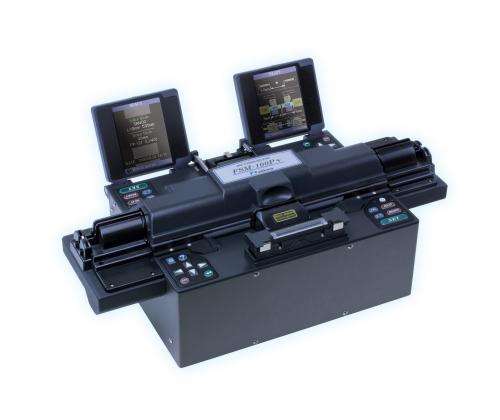New automated process simplifies alignment and splicing of multicore optical fibers

New multicore optical fibers have many times the signal-carrying capacity of traditional single-core fibers, but their use in telecommunications has been severely restricted because of the challenge in splicing them together— picture trying to match up and connect two separate boxes of spaghetti so that all of the noodles in each box are perfectly aligned. Now, a new splicing technique offers an automated way to do just that, with minimal losses in signal quality across the spliced sections. The method will be described at the Optical Fiber Communication Conference and Exposition/National Fiber Optic Engineers Conference (OFC/NFOEC) in Anaheim, Calif. March 17-21.
In the telecommunications industry, engineers maximize signal-carrying capacity using a process called multiplexing, which allows multiple signals or data streams to be combined within a single fiber cable. One digital phone line, for example, uses 64 kilobits per second of bandwidth, but with a technique called time multiplexing, more than 1.5 million phone conversations can take place at the same time, carried by one fiber core. With wavelength multiplexing, that one fiber core can send up to 200 different wavelengths of light simultaneously, increasing the capacity to 10 terabits per second, serving about 200 million phone lines. Those multiplexed fibers, in turn, can be bundled together into a so-called multicore fiber (MCF), consisting of up to 19 cores—and up to 19 times the signal-carrying capacity.
The challenge, however, is splicing those multicores together.
Researchers who work with MCFs in the lab usually have their own preferred manual processes for aligning and splicing fibers, explains Wenxin Zheng, manager of splice engineering at AFL in Duncan, S.C., who developed the new technique. "Although the manual way may be good for a skilled operator in a lab environment for research purposes, automation is the only path that can push MCF to factories and production lines."
In Zheng's process, which uses a Fujikura FSM-100P+ fusion splicer (see image), the fibers to be spliced are stripped and loaded into the splicer, then rotated and imaged with two video cameras so that their cores can be roughly aligned using a pattern-matching algorithm. Next, using a power-feedback method and image processing, a pair of corresponding cores in each fiber are finely aligned, as is the cladding around the cores. Finally, the cores are heat-spliced.
"To align the multiple cores simultaneously is a big challenge," Zheng says. "If two fibers to be spliced have random core locations, there is no way to align the entire core." However, the component cores of MCFs can be aligned if they are created using the same design standard, and if the cores are distributed symmetrically in the MCF—such as in a seven-core MCF with one central core surrounded by six cores oriented like the spokes of a wagon wheel. In that case, Zheng notes, "we can fine-align one side-core in an MCF and its cladding at the same time. Based on the geometric specifications of the fiber, the rest of the cores will be automatically aligned."
More information: Zheng's presentation, "Automated Alignment and Splicing for Multicore Fibers," will take place at 5 p.m. Monday, March 18 at the Anaheim Convention Center.
Provided by Optical Society of America




















